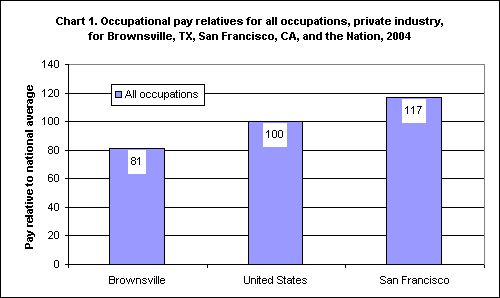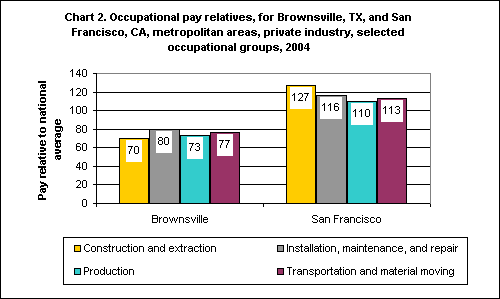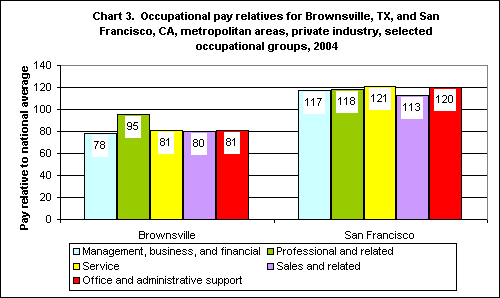| |
Printer-friendly version (HTML) |
Occupational Pay Relatives in San Francisco and Brownsville, 2004
by Lawrence H. Leith
Bureau of Labor Statistics
Originally Posted: March 29, 2006
Using data from the National Compensation Survey, the Bureau of Labor Statistics (BLS) produced occupational "pay relatives" to facilitate comparisons of occupational pay between metropolitan areas and the United States as a whole. Pay relatives for 2004 have been prepared for each of nine major occupational groups within 78 Metropolitan Statistical Areas (MSAs), as well as averaged across all occupations for each area. The pay relatives averaged for workers in all occupations in San Francisco and Brownsville were, respectively, the highest and lowest among the 78 areas. These data were first published in a news release entitled Occupational Pay Relatives, 2004 (USDL 05-2382, U.S. Department of Labor, December 28, 2005). BLS plans to publish new data on pay relatives annually.

- The San Francisco MSA recorded a pay relative of 117 in 2004, while the Brownsville, TX, MSA recorded a pay relative of 81. This means that the average rate of pay in the San Francisco area was 17 percent greater than the national average, while the average rate of pay in the Brownsville area was 19 percent below the national average.

- Among construction and extraction occupations, the 2004 pay relative was 127 in the San Francisco area and 70 in the Brownsville area. This means that the average rate of pay for this occupational group in the San Francisco area was 27 percent greater than the national average, while in the Brownsville area average pay for this group was 30 percent below the national average.

- Professional and related occupations in the San Francisco area earned 18 percent more than workers in that occupational group nationally. In Brownsville, professional and related occupations earned 5 percent less than the national average, which was the closest to the national rate of any of the nine major occupational groups in that MSA.
NOTE: Standard errors have been developed for the 2004 Occupational Pay Relatives, specifically for area pay relative to the national average; however, caution must be used when making inferences about an occupational wage in one area compared with that of another area. There is no statistical significance test for area-to-area comparisons.1 Research is currently being conducted by the BLS Office of Compensation and Working Conditions for the purpose of providing interarea standard errors for the Pay Relatives data. For research developments in this area, see the National Compensation Survey home page, on the Internet at http://www.bls.gov/ncs/home.htm.
SOURCE: National Compensation Survey, Wages
Lawrence H. Leith
Economist, Office of Publications and Special Studies, Bureau of Labor Statistics.
Telephone: (202) 691-7922; E-mail: Leith.Lawrence@bls.gov
Notes
1 For example, the 2004 pay relative for all private industry occupations was 117 for San Francisco and 81 for Brownsville. The San Francisco-to-Brownsville pay relative for all occupations, private industry, is calculated as follows:
(117/81) X 100 = 144
In this example, there is a pay premium of approximately 44 percent for all private industry occupations in San Francisco relative to all private industry occupations in Brownsville; however the difference in average pay between San Francisco and Brownsville may or may not be statistically significant.
|